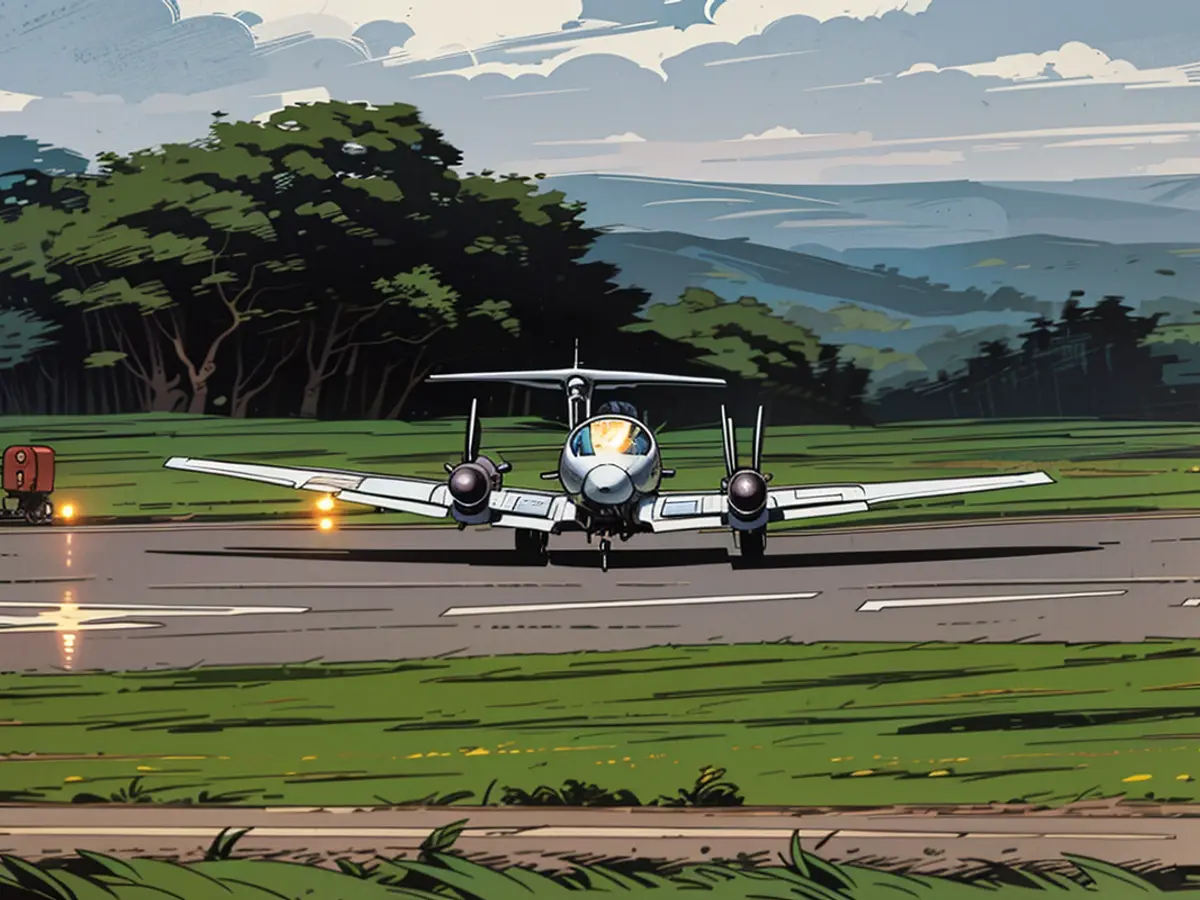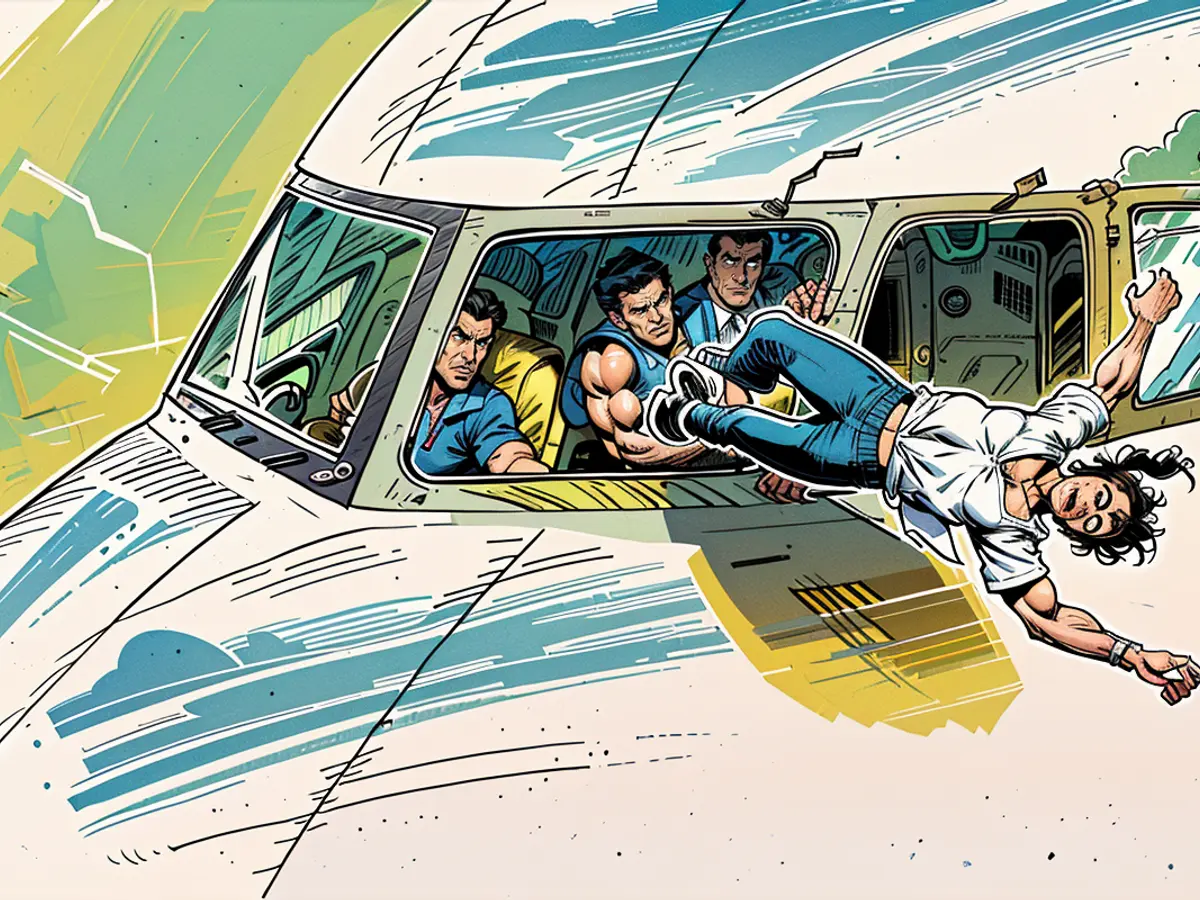Commemoration of the mishap - "Half the pilot is pulled from the aircraft": the incident in flight BA 5390
As British Airways flight 5390 departed from Birmingham Airport towards Malaga, Spain, on June 10, 1990, everything seemed normal with Timothy Lancaster, the pilot, and his 39-year-old co-pilot, Alastair Atchiston. They were joined by 81 passengers and four additional crew members. After taking off at 7:20 a.m. local time, the BAC-1-11 started cruising. However, trouble struck at approximately 7:33 a.m. when a loud noise filled the air over Didcot, Oxfordshire, at around 5,300 meters altitude.
The left windshield broke loose from the frame, leading to a pressure drop that dislodged the cockpit furnishing and labored equipment. The panicked crew scrambled for safety as items flew through the air while debris swirled in the cockpit. Nigel Ogden recalled, "I thought, 'Oh God, a bomb.'" The aircraft was rattling uncontrollably, and air passengers shrieked in fear. Debris was clouding the cabin, and a howling wind was drowning out all sound.
As Atchiston handed over control to Lancaster, the tragic moment arrived. Lancaster was near the window when the blast hit. His right leg was still inside when Nigel Ogden grasped him by the waist, pulling him back. The autopilot deactivated, and the aircraft began to lose altitude. It veered sharply downward at a six-degree angle, nose-dive of 25 degrees to the right. Furniture had landed on the navigational console, causing the aircraft to accelerate to 555 miles per hour.
Plunging through shards of glass, Lancaster bounced off the window frame and forward, and his head slammed against the intact side window. The cryogenic cold froze his limbs, and as the winds continued to blow fiercely, he was hovering half inside and half outside the aircraft. Alarmed, Nigel Ogden instantly reacted, allowing him to grab his pilot's waist, aborting the autopilot, and causing the aircraft to decline at an alarming rate. Since there were no automatic oxygen masks on board, aircrew and cabin personnel were scrambling.
The pilot could barley hear the air traffic controller over the vicious roar. Cabin crew Susan Gibbins and Simon Rogers had to accept that passengers were panicking and finally, the third steward, Simon Rogers, noticed the carnage. Aghast, he saw John Heward and Nigel Ogden frantically holding Lancaster's waist to prevent him from flying away. Ogden remembered, "I can only recall Tim's flailing arms. They seemed about 1.80 meters long and it seemed that he had very wide open eyes pressed against the plane side. I thought to myself, 'I think he's dead.'"
Under immense force, the pilot's shoulder dislocated, and frostbite set in as the icy airflow started affecting his arms and left eye. These conditions would soon have him pulled almost entirely from the craft. If any part of his body hit the engine or wing, a catastrophe was imminent.
It took Atchiston seven strenuous minutes to receive the system controller's voice for the first time. Concerned about the plane's weight from the unburned kerosene and the potential for a tire bust, he requested a 2500-meter runway at the southern English airport, Gatwick Airport. However, the closer Southampton Airport was: even though the runway was only 1700 meters long, they had to land the crippled aircraft as quickly as possible.
The pilot's body emitted a frigid chill, and his dislocated shoulder was strained by the uncontrolled winds. The three crew members' brave efforts prevented him from being entirely sucked out of the airplane. Their swift actions prevented a more catastrophic accident.
Yet, with the cracked window, the essential checklists and plans for an unexpected touchdown at a foreign airport were swept away. Now, just air traffic controller Chris Rundle could aid him. He inquires if any other predicaments were present on board, excluding the abrupt pressure release within the aircraft. Atchison replies, "The commanding officer has half absorbed from the vehicle. It appears he's deceased." Air traffic controller Chris Rundle nearly struggles to believe this: "You mostly experience such realities on the big screen, but not in real life," he recalls. "You don't think it's achievable, yet it has to be."
In 1990, the windshield of British Airways Flight 5390 came off at an altitude of 17,000 feet. This triggered a sudden decompression in the cockpit, resulting in the captain being partially ejected out of the aircraft.
As luck would have it, Nigel Ogden, a flight attendant,… pic.twitter.com/nULmfc2Pbl— Fascinating (@fasc1nate) January 7, 2024
Precisely 35 minutes after takeoff from Birmingham and 20 minutes after the window detached containing the pilot, Alastair Atchison attempts the hardest landing of his existence. At 7:55 am, BA 5390 securely executes touchdown at Southampton Airport. Emergency personnel envelop the plane swiftly, and passengers are guided out through the front and rear stairs, while the nearby fire department extracts the pilots from the vehicle. Astoundingly, he has survived the ordeal. Enduring shock, bruises, trace of bleeding, and shattered bones in his right arm and wrist.
"I was acutely conscious that I was rising"
Despite being mostly unconscious, reminiscences of the happenstance begin reemerging in the hospital. "There was a deafening clip, a sound as all the air drained out. However, I recollect how the windshield separated from the plane and afterward - like a ball - disappeared into the distance. And I was incredibly cognizant that I was ascending." Although he sensed he was only partially detached from the plane, it didn't worry him. What stood out most to him was that he couldn't breathe. "Thus, I maneuvered my frame around. In that instant, I tilted my back over the plane and I could travel." He also recalls the rotating propellers and the perspective of the plane's rear. "That's where my recollections conclude." Fascinatingly: Five months later, he continues his work as a pilot.
The wrecked windshield is subsequently discovered near Cholsey, Oxfordshire. An investigative board determines that 84 of the 90 bolts employed were too slender. The remaining six head screws were too short. A cardinal blunder. Distinct from other aircraft where the windshields are installed from within the cabin, the BAC 1-11's windshield is fastened from without. The grand amount of screws is necessary to block air from exiting through the window seals. Any deficiency in the bolts could indicate that the plane's pressure would eject the windshield.
When the examiners confront the department supervisor with the flawed screws, he is taken aback. He himself had decided on the replacement screws due to his own estimates and set up the windshield. What he had not grasped: The preliminary forward windshield was also fitted with substandard screws. At least these had been adequately robust to keep the windshield intact for four years without complications.
Since he had not changed his windshield for two years, he had just eavesdropped on the maintenance log that morn to revise his mindset. He sauntered to the parts bin retrieving the screws from the former windshield to buy new ones. There, he identified them as A211-7D screws. In spite of the warehouse supervisor highlighting that A211-8D screws should be employed for this windshield, he disregarded him. He couldn't uncover sufficient screws, so he plundered a few from another hanger, but in the dim light, he didn't realize that they were too tight. Because the plane was placed improperly in the hangar, he needed to twist his body markedly over the nose of the aviation machine to set up the screws. As a result of the angle, he could not perceive that the fasteners didn't fit well. Around 6 am, he affirmed the maintenance papers and the place was prepared to hand it over to the pilots.
Copilot Alastair Atchison and cabin staff members Susan Gibbins and Nigel Ogden received the Queen's Commendation for Significant Service in the Air for their valiant deeds. Atchison likewise acquired the Polaris Award for astonishing airline achievement in 1992. The plane was repaired and put back in operation. In spite of the accident, all colleagues resumed their occupations. However, Ogden, who suffered from post-traumatic anxiety disorder, retired in 2001 for health factors and subsequently worked as a night patrol at a Salvation Army clinic.

Read also:
The headlines around the world about the incident featured "British Airways Flight 5390" as top news due to the unexpected decompression that occurred at 5,300 meters altitude. Despite the pilot's partial ejection, the crew managed to safely land the aircraft at Southampton Airport, making it one of the most miraculous flight emergency landings in history.
In the aftermath of the incident, the world watched as the British Airways pilot gave an interview, recounting his experience of being partially ejected from the cockpit and the steps he took to remain inside the aircraft. This shocking event became a topic of discussion in the top news headlines worldwide.






